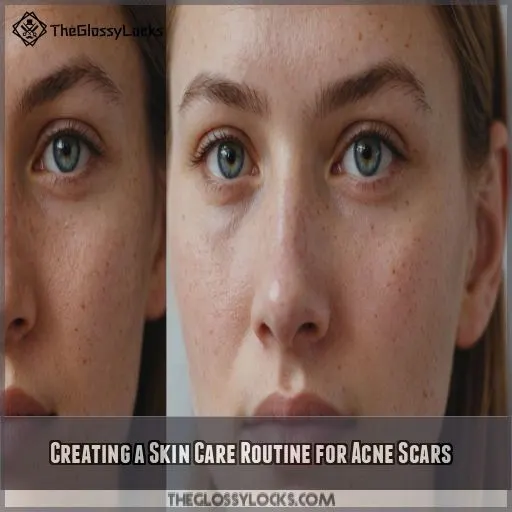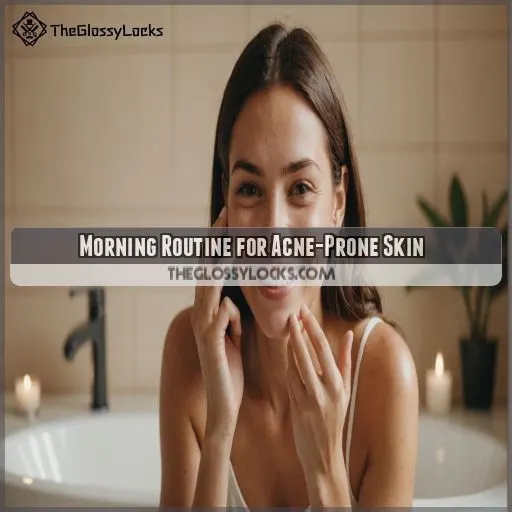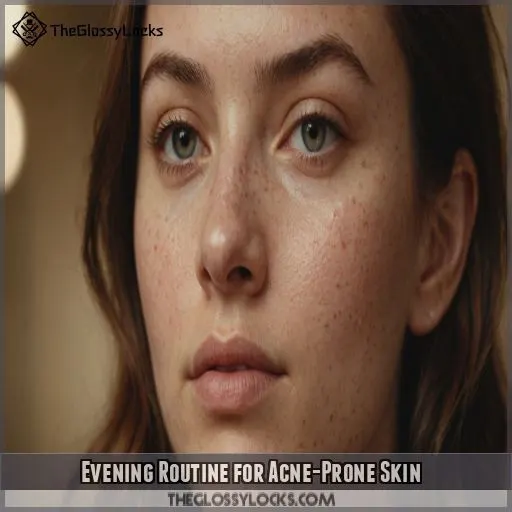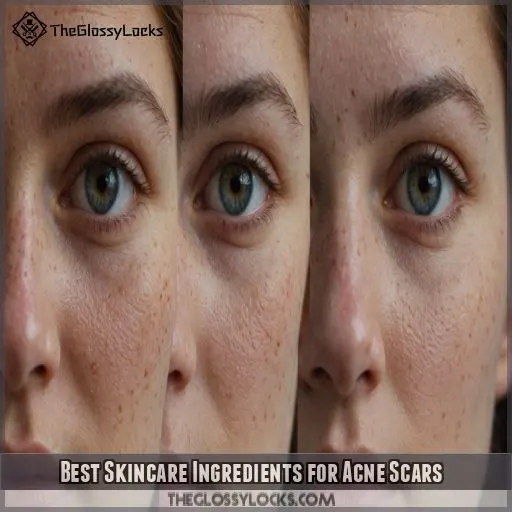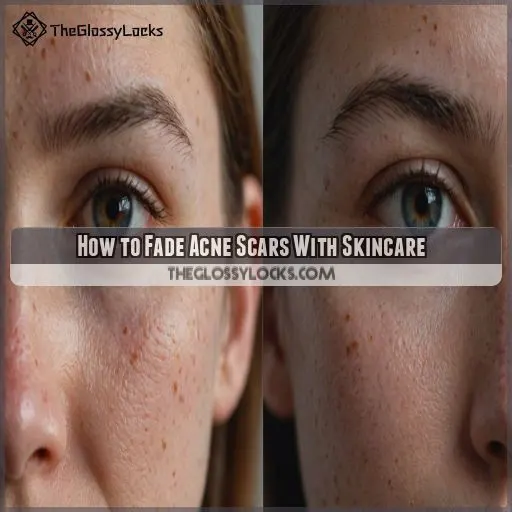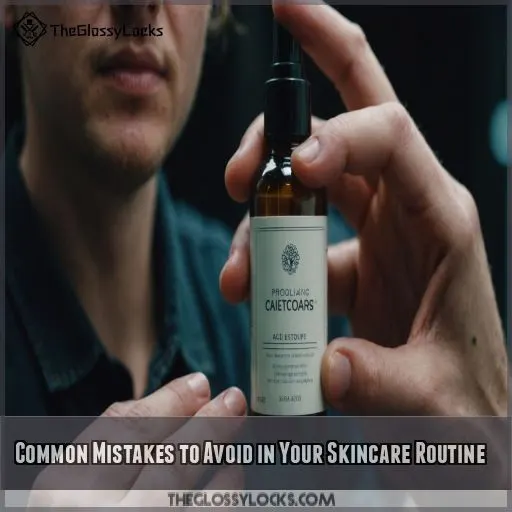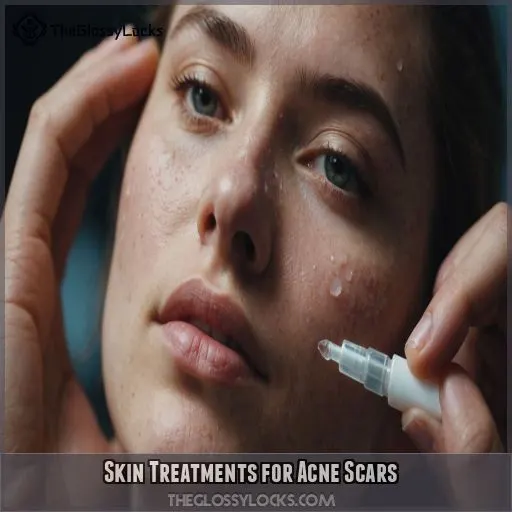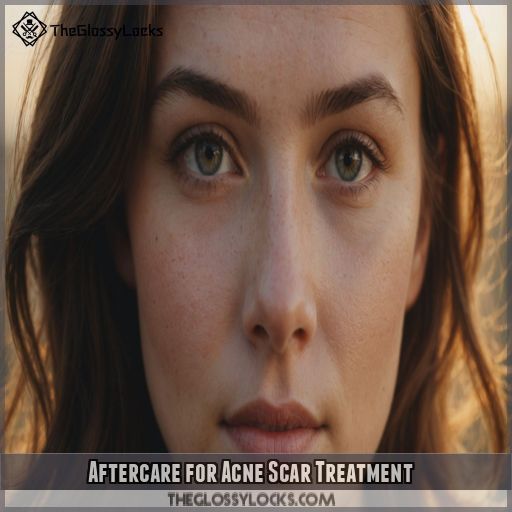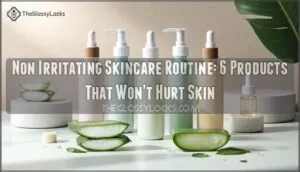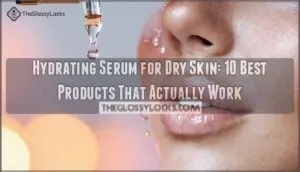This site is supported by our readers. We may earn a commission, at no cost to you, if you purchase through links.
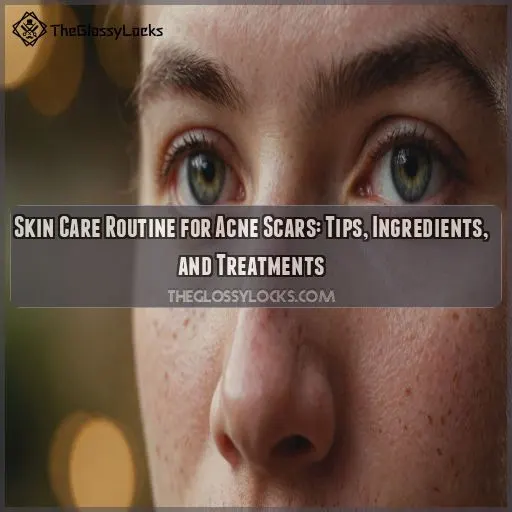 You’ll transform your acne-scarred skin with a targeted skincare routine that combines gentle cleansing, potent active ingredients, and consistent sun protection.
You’ll transform your acne-scarred skin with a targeted skincare routine that combines gentle cleansing, potent active ingredients, and consistent sun protection.
Start by identifying your skin type and concerns, then choose products with acne-fighting ingredients like benzoyl peroxide, retinoids, and salicylic acid.
Don’t forget to moisturize and apply sunscreen daily to prevent further damage.
In the evening, focus on exfoliation and hydration with ingredients like niacinamide or hyaluronic acid.
Table Of Contents
- Key Takeaways
- Creating a Skin Care Routine for Acne Scars
- Morning Routine for Acne-Prone Skin
- Evening Routine for Acne-Prone Skin
- Best Skincare Ingredients for Acne Scars
- How to Fade Acne Scars With Skincare
- Common Mistakes to Avoid in Your Skincare Routine
- Skin Treatments for Acne Scars
- Aftercare for Acne Scar Treatment
- Frequently Asked Questions (FAQs)
- What is the best skin care routine for acne scars?
- Can skincare remove acne scars?
- How can I fade my acne scars?
- What skin treatments are good for acne scars?
- How long does it take to see results?
- Can diet affect acne scars and their healing?
- Are natural remedies effective for treating acne scars?
- How often should I exfoliate acne-scarred skin?
- Can makeup be safely used on acne scars?
- Conclusion
Key Takeaways
- You’ll want to tailor your routine to your specific skin type and concerns – think of it like finding the perfect pair of jeans that fits you just right. Start by identifying whether you’re oily, dry, or combination, and choose products that cater to your unique skin needs.
- Don’t be afraid to embrace the power of active ingredients. Retinoids, salicylic acid, and niacinamide are your skin’s best friends when it comes to fighting acne scars. Just remember to introduce them slowly – your skin isn’t a fan of shock therapy!
- Consistency is key, so stick to your routine like you’d stick to your favorite Netflix series. Cleanse, treat, moisturize, and protect – it’s your skin’s daily pep talk. And don’t forget the sunscreen – it’s like an invisible shield against further damage.
- Be patient and kind to your skin – Rome wasn’t built in a day, and neither is flawless skin. It might take weeks or even months to see results, but trust the process. Your future self (and selfies) will thank you for it!
Creating a Skin Care Routine for Acne Scars
If you’re struggling with acne scars, you’re not alone. This guide will help you create a personalized skin care routine to tackle those scars and boost your confidence.
We’ll explore the best ingredients and practices to fade those marks, giving you clear, healthy skin.
Understanding Your Skin Type and Concerns
Understanding your skin type and concerns is the first step to creating an effective skincare routine for acne scars. Here’s a guide to help you navigate skincare and achieve your skin goals:
- Identify your skin type: Is it oily, dry, combination, or sensitive? This knowledge will help you choose the right products and create a personalized routine.
- Recognize your skin concerns: Are you dealing with acne scars, post-acne marks, uneven skin texture, or dark spots? Understanding your specific concerns will help you target them effectively.
- Consider your skin sensitivity: How does your skin react to new products or ingredients? Knowing your skin’s sensitivity level will guide you in selecting gentle, effective formulas.
- Evaluate your skin texture and tone: Are there areas of your skin that feel rough or look uneven? Paying attention to your skin’s texture and tone will help you achieve a smooth, radiant complexion.
Identifying the Right Products for Your Skin
Now that you’ve got a handle on your skin type, it’s time to identify the right products for your skincare routine. This can feel like a maze, especially with the endless options available.
Here’s a quick guide to help you choose products that suit your skin’s needs.
- Don’t fall for hype or popularity: What works for your bestie mightn’t work for you. Opting for cult-favorite products isn’t always the best route.
- Seek out specific ingredients: Look for products containing ingredients suited to your skin type. For instance, if you have oily skin, seek out alpha hydroxy acids (like glycolic or salicylic acid), benzoyl peroxide, and hyaluronic acid. For dry skin, shea butter and lactic acid are great. If you have sensitive skin, go for aloe vera, oatmeal, and shea butter.
- Avoid certain ingredients: Fragrance/parfum, sulfates, parabens, and formaldehyde can cause skin allergies, irritation, and hormonal imbalances.
- Beware of "natural" claims: Natural doesn’t always mean better. Some natural ingredients, similar to harsh chemicals in shampoos Damaging Hair Products, can cause adverse reactions .
.
- Check the order of ingredients: Look at the first five ingredients, as they make up about 80% of the product. If problematic ingredients are listed first, or good ingredients last, reconsider.
- Don’t fear long ingredients lists: Longer lists are common in anti-aging products and medical-grade skincare. Use online resources like EWG’s Skin Deep database and CosDNA to help you out.
- Always patch test: Test new products on a small area of skin to make sure they don’t irritate your skin.
Customizing Your Routine for Acne Scars
Now for the fun part: creating a skincare routine to fade those acne scars. The best routine for you’ll depend on your skin type and the types of scars you have.
First, a quick recap on product choices:
- Opt for gentle, non-medicated cleansers if you’re using prescription acne treatments.
- Avoid harsh chemicals and opt for natural oils instead.
- Use products with active ingredients like azelaic acid, retinoids, benzoyl peroxide, and salicylic acid.
- Look for ingredients like hyaluronic acid, niacinamide, and vitamin C to reduce inflammation and promote skin renewal.
- Sunscreen is a must to prevent scars from darkening.
Let’s get started with a simple morning and evening skincare routine:
- Cleanse: Start your day with a gentle cleanser to remove any overnight buildup of oils and dirt.
- Treat: Apply your acne treatment products, such as gels or spot treatments containing salicylic acid or benzoyl peroxide.
- Moisturize: Use a lightweight, Moisturize: Use a lightweight, oil-free moisturizer with Hyaluronic Acid Benefits to hydrate your skin without clogging pores.
.
- Protect: Finish with a broad-spectrum sunscreen of SPF 30 or higher to shield your skin from darkening and further damage.
- Double Cleanse: At the end of the day, use an oil-based cleanser to remove makeup, followed by your gentle cleanser to make sure your skin is thoroughly cleansed.
- Treat: Apply your retinol or exfoliating products to increase cell turnover and promote skin renewal.
- Moisturize: Hydrate your skin with a moisturizer containing ingredients like niacinamide or hyaluronic acid to reduce inflammation and promote healing.
Morning Routine for Acne-Prone Skin
Morning routines are really important for setting the tone for the day, especially if you’re dealing with acne-prone skin. Here’s a simple, effective routine to help you start your day with a fresh, healthy canvas.
Step 1: Cleanse and Treat With Gentle Products
For your morning routine, it’s important to start with a gentle cleanser that won’t strip your skin. Opt for gentle cleansers with ingredients like glycerin, chamomile, and aloe vera, which are soothing and hydrating. Steer clear of harsh soaps and physical exfoliants, especially if you have acne-prone skin.
Micellar water is a fantastic option for a gentle yet effective cleanse. These soap-free, no-rinse cleansers use micelles (tiny molecules) to attract and remove dirt, makeup, and excess oil without irritating your skin. They’re perfect for minimalists or those short on time. Look for formulas with hydrating ingredients like Vitamin B5 Benefits, hyaluronic acid, and ceramides.
, hyaluronic acid, and ceramides.
If you prefer a more traditional cleanser, there are plenty of gentle options available. For instance, For instance, a gel cleanser with glycolic acid, similar to those found in chemical exfoliator options, can offer gentle exfoliation without drying out your skin.
. Or, if you’re a fan of a creamy cleanser, choose one with ingredients like ceramides and glycerin to nourish and hydrate your skin.
Step 2: Moisturize and Protect With Non-Comedogenic Products
Now that you’ve cleansed your skin, it’s time to moisturize and protect it with non-comedogenic products. Non-comedogenic simply means that a product is formulated to avoid clogging your pores, which is music to the ears of anyone with acne-prone skin.
When choosing a moisturizer, look for labels like "non-comedogenic," "non-pore clogging," "for acne-prone skin," and "dermatologist-tested." These products are designed to provide hydration without risking breakouts. You can further make sure a product is non-comedogenic by checking its comedogenic rating, which indicates how likely it’s to clog your pores.
Here are some recommended non-comedogenic moisturizers:
- La Roche-Posay Effaclar Mat Mattifying Moisturizer
- Cetaphil Dermacontrol Non-Comedogenic Moisturizer for Acne-Prone Skin
- CeraVe AM Facial Moisturizing Lotion with Sunscreen
- Tatcha The Water Cream
- Neutrogena Hydro Boost Face Moisturizer
- Kiehl’s Ultra Facial Oil-Free Gel Cream
- La Roche-Posay Toleriane Double Repair Face Moisturizer
- EltaMD UV Clear Tinted Broad-Spectrum SPF 46
Step 3: Apply Sunscreen With Broad-Spectrum Protection
Now that you’ve cleansed, treated, and moisturized, it’s time to protect your skin with sunscreen. This step is non-negotiable, even if you’re spending most of your day indoors.
Why is sunscreen so important?
- It protects your skin from sun damage and lowers your risk of skin cancer.
- It helps prevent premature skin aging, including wrinkles, sagging, and age spots.
- It’s an essential part of a good sun protection strategy, along with seeking shade and wearing sun-protective clothing.
Here are some key tips for choosing and applying sunscreen:
- Look for broad-spectrum protection: This means the sunscreen protects against both UVA (aging) and UVB (burning) rays.
- Choose an SPF of 30 or higher for adequate protection. SPF 30 blocks 97% of UVB rays, while SPF 15 blocks 94%.
- Apply sunscreen 15 minutes before sun exposure to allow it to absorb and provide maximum benefit.
- Reapply sunscreen every two hours, and more often if you’re sweating or swimming.
- Don’t forget to cover often-missed spots like the tops of your feet, neck, ears, and scalp.
Evening Routine for Acne-Prone Skin
As the day winds down, it’s time to give your skin some extra TLC with an evening routine designed for acne-prone skin. We’ll walk you through the steps to cleanse, treat, and hydrate your way to clearer skin while you catch some z’s.
Step 1: Double Cleanse to Remove Makeup and Impurities
The first step in your evening skincare routine is to double cleanse. This is a two-step process that starts with an oil-based cleanser to break down makeup, sunscreen, and other impurities. Next, use a water-based cleanser to thoroughly cleanse your skin and remove any remaining residue.
Double cleansing is a must for acne-prone skin, as it makes sure your skin is truly clean and ready for the rest of your skincare routine. It’s a gentle yet effective way to keep your skin happy and healthy.
Step 2: Improve Skin Texture With Retinol or Exfoliants
When it comes to improving skin texture, you’ve got two powerful options: retinol or exfoliants. But how do you choose between these two skincare superstars? Let’s break it down.
First, let’s clarify the difference. Retinol is a form of vitamin A that boosts cell turnover, fades hyperpigmentation, treats acne, and improves skin texture. While it may cause peeling and can be drying, it’s technically not an exfoliant. Exfoliants, on the other hand, Exfoliants, on the other hand, directly remove dead skin cells from the surface of the skin, either physically (think scrubs) or chemically (using acids like AHAs) to promote Skin Renewal After Microneedling.
, either physically (think scrubs) or chemically (using acids like AHAs).
If you’re new to retinol, it’s best to start with a lower strength (around 0.05%) to give your skin time to adjust. You can gradually increase the frequency and strength over time. For exfoliants, you’ll want to be cautious too, especially if you’re using physical exfoliants, as they can be irritating.
Look for chemical exfoliants with alpha-hydroxy acids (AHAs) like glycolic or lactic acid, or beta-hydroxy acids (BHAs) like salicylic acid. These will help gently exfoliate and unclog pores without being too harsh.
Retinol can cause redness, dryness, and irritation, especially in the beginning. This is why it’s important to introduce it slowly and choose the right strength for your skin. If you have sensitive skin, you may want to opt for exfoliants first and introduce retinol gradually.
Both retinol and exfoliants can make a big difference in improving skin texture. Retinol does this by boosting cell turnover and collagen production, while exfoliants work by directly removing dead skin cells, giving your complexion a smoother, more refined appearance.
The bottom line? Both retinol and exfoliants are powerful tools in your skincare arsenal. Choose one or alternate between the two, depending on your skin’s needs and tolerance.
Step 3: Moisturize and Hydrate With Niacinamide or Hyaluronic Acid
Now that you’ve exfoliated, it’s time to moisturize and hydrate.
Niacinamide and hyaluronic acid are both excellent options for this step, offering distinct advantages for acne-prone skin.
Niacinamide, a form of vitamin B3, helps regulate oil production, reduce inflammation, and improve uneven skin tone. It’s an excellent choice if you’re dealing with acne, redness, or excess oil.
On the other hand, hyaluronic acid is a natural hydrator, known for its ability to retain moisture. It plumps up the skin, reducing the appearance of fine lines and wrinkles, and is suitable even for sensitive and acne-prone skin.
You can use either of these ingredients or combine them for a powerful skincare duo. If you opt for hyaluronic acid, remember to apply it to damp skin to lock in moisture effectively.
Best Skincare Ingredients for Acne Scars
Acne scars can be a real pain, but the right ingredients in your skincare routine can help fade them away. Here’s a list of the best active ingredients to look out for when shopping for acne scar-busting products.
Benzoyl Peroxide for Killing Bacteria and Reducing Inflammation
Benzoyl peroxide is a popular acne-fighting ingredient, killing the bacteria that causes acne and reducing inflammation. It’s available over the counter in gels, cleansers, and spot treatments, with concentrations ranging from 2.5% to 10%.
While effective at treating mild to moderate inflammatory acne, it may not be suitable for sensitive skin as it can cause dryness, redness, and irritation. It’s also known to stain clothing and hair, so be cautious when applying.
For inflammatory acne, benzoyl peroxide is a great option, but for noninflammatory acne, consider salicylic acid, which exfoliates and clears out pores.
Retinoids for Preventing Clogged Pores and Reducing Scarring
Retinoids are a class of vitamin A-derived compounds that can help prevent clogged pores and reduce acne scarring.
Retinoids come in various forms, from over-the-counter (OTC) to prescription-strength, including:
- Retinoid creams, foams, and gels: These treat oil production, bacteria, and inflammation associated with acne.
- Tretinoin: A prescription retinoid that treats wrinkles and acne scars.
- Isotretinoin: An oral medication prescribed for severe acne.
- Adapalene: A retinoid that slows excessive growth in pores and reduces inflammation.
- Retinoid esters: The weakest form, ideal for beginners or sensitive skin.
- Retinoic acid: Works faster than retinol due to direct absorption.
While retinoids offer numerous benefits, they may cause initial redness, peeling, and even worsen acne before improving. Additionally, stronger forms may lead to:
- Dryness and irritation.
- Sensitivity to sunlight.
- Extreme skin sensitivity.
- Stinging and blistering.
When using retinoids, follow these tips:
- Start with a small amount, like a pea-sized drop, and apply it to your entire face.
- Begin by using it every other day until your skin adjusts.
- Always follow with a gentle, non-comedogenic moisturizer.
- Be cautious if you have sensitive skin, performing a patch test first.
- Avoid direct sunlight, and always use sunscreen when using retinoids.
Retinoids may take several months to show visible results, but they’re a powerful tool in combating acne and reducing scarring.
Salicylic Acid for Exfoliating and Unclogging Pores
Salicylic acid is your secret weapon against stubborn acne scars.
This beta-hydroxy acid works wonders by diving deep into your pores, sweeping away dead skin cells and excess oil.
It’s like a gentle street sweeper for your face!
By unclogging pores, it helps prevent new breakouts but also smooths out your skin’s texture.
Just remember, moderation is key – start with once or twice a week and listen to your skin’s needs.
Niacinamide for Regulating Sebum Production and Reducing Inflammation
While salicylic acid tackles those pesky pores, niacinamide is your skin’s secret weapon against excess oil.
This powerhouse ingredient is like a traffic cop for your sebum, keeping oil production in check.
But that’s not all – it’s also a champion at calming inflammation.
If your acne-prone skin is throwing a tantrum, niacinamide can help soothe the storm, leaving you with a clearer, more balanced complexion.
How to Fade Acne Scars With Skincare
Fading acne scars doesn’t have to be a mystery – with the right skincare routine, you can make a real difference. Let’s explore some effective techniques using spot treatments and Effortless Removal Methods that can help fade those pesky reminders of past breakouts.
.
Applying Spot Treatments With Hydroquinone or Kojic Acid
Spot treatments can be your secret weapon against stubborn acne scars. Hydroquinone and kojic acid are two powerhouse ingredients that can help fade those pesky marks. Here’s what you need to know:
- Apply spot treatments once or twice daily, but listen to your skin
- Hydroquinone is stronger, while kojic acid is gentler on sensitive skin
- Always do a patch test first to avoid potential irritation
Exfoliating With Alpha Hydroxy Acids or Beta Hydroxy Acids
Ever wondered how to boost your acne scar-fighting routine?
AHAs and BHAs are your secret weapons.
These powerhouse exfoliants work differently but share a common goal: revealing brighter, smoother skin.
While AHAs like glycolic acid work on the surface, BHAs like salicylic acid dive deep into pores.
Start with once-weekly use, increasing gradually based on your skin’s response.
Common Mistakes to Avoid in Your Skincare Routine
For treating acne scars, your skincare routine can make or break your progress. Let’s explore some common pitfalls to avoid, so you can maximize your results and keep your skin happy and healthy.
Using Harsh or Drying Products That Can Worsen Acne
In your quest for clear skin, harsh products can be a wolf in sheep’s clothing. They might promise quick fixes, but often do more harm than good. Here’s why you should steer clear:
- They strip your skin’s natural oils, triggering more oil production
- Harsh ingredients can irritate sensitive skin, causing redness and inflammation
- Over-drying leads to a compromised skin barrier, making you more prone to breakouts
Not Following a Consistent Skincare Routine
While harsh products can wreak havoc, inconsistency is another acne-fighting foe.
You wouldn’t expect a plant to thrive with sporadic watering, right?
Your skin’s no different.
Sticking to your routine is like giving your skin a daily pep talk.
It’s easy to skip steps when you’re tired, but remember: your future self will thank you.
Make your routine a non-negotiable part of your day, just like brushing your teeth.
Not Protecting Your Skin From the Sun
Consistency is key, but don’t forget about the silent skin saboteur: the sun. Skipping sun protection is like leaving your front door wide open for burglars. UV rays can worsen acne scars and cause hyperpigmentation, undoing all your hard work. Here’s why you should never skimp on sunscreen:
- It prevents further darkening of acne scars
- It protects against premature aging
- It reduces the risk of skin cancer
Skin Treatments for Acne Scars
If you’re dealing with stubborn acne scars, there’s hope beyond just skincare products. Professional skin treatments like chemical peels, microdermabrasion, and laser therapy can work wonders for exfoliating, brightening, and improving your skin’s texture.
Chemical Peels for Exfoliating and Brightening the Skin
Chemical peels can be your skin’s secret weapon against acne scars. They work by removing the top layer of skin, revealing a brighter, smoother complexion underneath. Let’s break down the types of peels, their benefits, and what to expect:
| Peel Type | Benefits | Downtime |
|---|---|---|
| Superficial | Mild exfoliation, brightening | 1-3 days |
| Medium | Reduce fine lines, improve texture | 3-7 days |
| Deep | Significant scar reduction | 1-2 weeks |
| At-home | Gentle exfoliation, convenience | None |
| Professional | Customized treatment, stronger results | Varies |
Microdermabrasion for Improving Skin Texture and Reducing Scarring
Smoothing out your skin’s bumpy road with microdermabrasion can be a game-changer for acne scars.
This treatment gently buffs away dead skin cells, revealing a fresh, glowing complexion underneath.
You’ve got options: try at-home devices for a DIY approach, or go pro for more intensive results.
Either way, you’re on track to improve skin texture and reduce those pesky scars.
Just remember, Rome wasn’t built in a day – patience is key!
Laser Therapy for Stimulating Collagen Production and Reducing Scarring
Laser therapy might be your secret weapon for tackling those stubborn acne scars. This high-tech treatment stimulates collagen production and can really help reduce scarring. Here’s what you need to know:
- Types: Fractional, CO2, and Erbium lasers
- Downtime: Varies from 1-2 weeks, depending on intensity
- Cost: Generally pricier than other treatments, but often worth it
- Best for: Atrophic scars, including boxcar and ice pick scars
Results aren’t instant, but you’ll likely see improvements within 3-6 months. It’s like giving your skin a time machine!
Aftercare for Acne Scar Treatment
You’ve taken the first step to smoother skin by getting acne scar treatment, but your journey isn’t over yet. Proper aftercare is key for maximizing your results and ensuring your skin heals beautifully, so let’s explore how to pamper your newly-treated skin.
Following Your Dermatologist’s Instructions for Post-Treatment Care
After your acne scar treatment, it’s really important to follow your dermatologist’s instructions to the letter.
Think of it as a roadmap to healing – every step matters!
Use the recommended skincare products, steer clear of makeup until given the green light, and keep your skin clean to ward off infections.
Your skin’s journey to recovery is unique, just like you!
Protecting Your Skin From the Sun and Preventing Darkening
The sun can be your skin’s worst enemy after acne scar treatment.
You’ll want to shield your delicate skin like it’s a precious treasure.
Avoid tanning and sun exposure for 6-8 weeks post-treatment, even on cloudy days.
Slather on a broad-spectrum SPF 30+ sunscreen daily to prevent darkening.
Keeping Your Skin Clean and Hydrated to Promote Healing
- Use gentle cleansers that won’t strip your skin
- Pat dry with a soft towel – no rough stuff!
- Apply a non-comedogenic moisturizer to lock in hydration
- Drink plenty of water to hydrate from the inside out
Frequently Asked Questions (FAQs)
What is the best skin care routine for acne scars?
Did you know 95% of acne sufferers develop scars? Don’t worry, you’re not alone! Cleanse gently, exfoliate with AHAs, apply retinoids, and always use sunscreen. Patience is key – your skin’s on a journey to smoother days ahead.
Can skincare remove acne scars?
While skincare can’t completely remove acne scars, it can make a big difference in how they look. You’ll need patience and the right products. Retinoids, AHAs, and vitamin C are your best friends in this battle against stubborn scars.
How can I fade my acne scars?
Did you know 95% of acne scars fade within a year? To speed things up, try using retinoids, vitamin C serums, and chemical peels. Don’t forget sunscreen – it’s your BFF in preventing dark spots from sticking around!
What skin treatments are good for acne scars?
You’ve got options! Try retinoids to boost cell turnover, chemical peels for exfoliation, or microneedling to stimulate collagen. Laser treatments can target specific scars, while dermal fillers plump up indented areas. Always consult a dermatologist for personalized advice.
How long does it take to see results?
You’ll need patience, as results can take weeks to months. It’s not an overnight fix! Stick to your routine, and you’ll start seeing improvements. Remember, everyone’s skin is different, so your journey’s unique.
Can diet affect acne scars and their healing?
Your diet can indeed influence acne scars and healing. Eating nutrient-rich foods boosts collagen production and skin repair. Cut back on sugar and dairy, which may worsen inflammation. Remember, you’re nourishing your skin from the inside out!
Are natural remedies effective for treating acne scars?
While some natural remedies show promise, their effectiveness for acne scars isn’t well-proven. You’re better off sticking to dermatologist-recommended treatments. But hey, if you want to try grandma’s honey mask, it won’t hurt – just don’t expect miracles!
How often should I exfoliate acne-scarred skin?
Did you know that 95% of acne sufferers develop some scarring? For your acne-scarred skin, exfoliate gently 1-2 times a week. You’ll want to tread lightly – think of your skin as a delicate masterpiece you’re restoring.
Can makeup be safely used on acne scars?
You can use makeup on acne scars, but choose non-comedogenic products to avoid clogging pores. Primer can help smooth texture, while color-correcting concealer masks redness. Remember to remove makeup thoroughly at night to keep skin healthy.
Conclusion
Starting a skin care routine for acne scars can feel like climbing a mountain, but don’t let that discourage you!
With patience and consistency, you’ll see remarkable improvements.
Stick to your routine, protect your skin from the sun, and don’t hesitate to consult a dermatologist for personalized advice.
You’re on your way to smoother, clearer skin – and that’s something to smile about!

